When planning our trip to Florida the one place I wanted to see more than any other was Fairchild Tropical Botanic Garden. While visiting their website to get particulars, I noticed they were offering free admission on the first Wednesday of each month this summer, including July 4th, so there was no doubt as to where I would spend my Independence Day. If you want to know more about Fairchild, I suggest you visit their website where their story is certainly told better. However, I would just like to say that if you ever find yourself in the vicinity of Miami, you must go, this is more than a pretty garden, it is a world class facility.
Let's descend the steps at the visitor's center and enter the garden.
Being a tree person, I was immediately impressed with rainbow eucalyptus (Eucalyptus deglupta). It has bark that can make men weep.
There were many Ficus in the garden. This Ficus racemosa was part of an art installation from Yoko Ono, one of her Wish Trees. We also saw one a couple of years ago at MOMA in New York. It is hard to tell from the photo, but the diameter of this trunk was easily 10'.
Ficus subcordata
This ponytail palm (Beaucarnea recurvata) is not technically a palm, and may not even be a tree, but it was spectacular.
I could not find out what tree this was, but I love the womanly trunk flare.
* (Thanks to Barry for the subsequent ID of Pachira aquatica.)
Care to climb the silk floss tree (Ceiba speciosa)?
As one would expect, Fairchild has a fantastic palm collection, and if I was British I'd say it left me gobsmacked. Since I am not a Brit, and it was July 4th, here is a photo appropriate for the day.
Copernicia macroglossa, pettycoat palm
These are Bailey palms from Cuba (Copernica baileyana). They looked to be made of concrete, and I could imagine planting of line of them to resemble a colonnade.
I didn't get the name of these palms, but liked how they were underplanted with Philodendron.
The trees pictured below are Haitian oil palms (Attalea crassispatha). In the ecological nightmare that is Haiti they are extinct, and these 15 are the last ones left in the world.
We will end with yet another shot of the plant geek and his Bismarckii nobilis.
We will continue our Fairchild tour in the next post with a bit more color.
Subscribe to:
Post Comments (Atom)


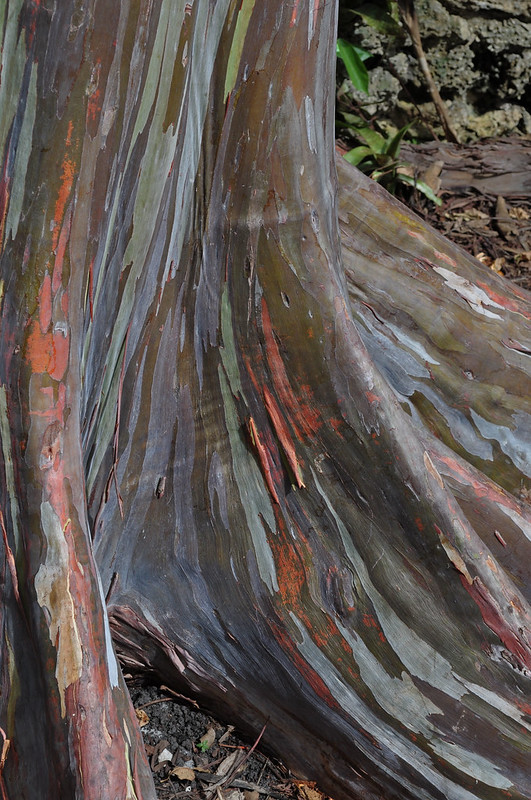
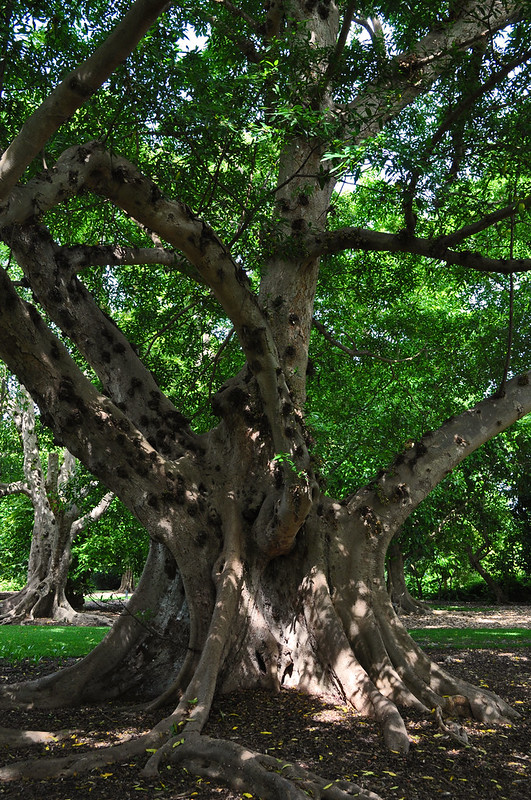





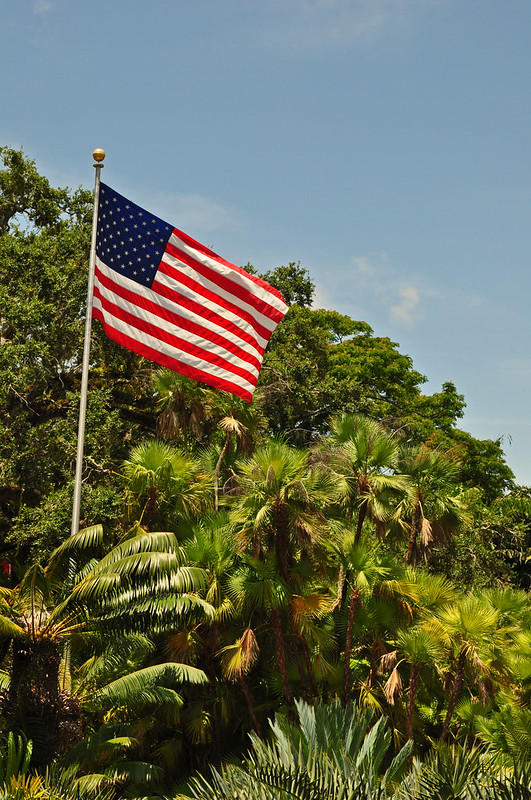
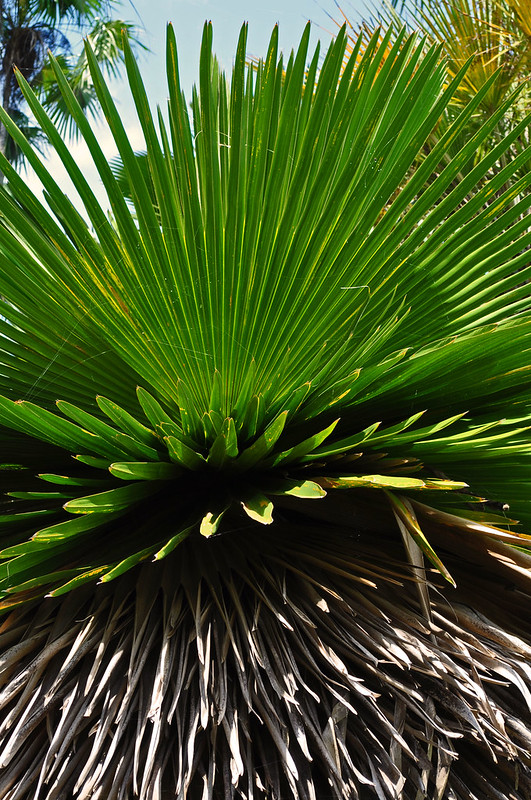


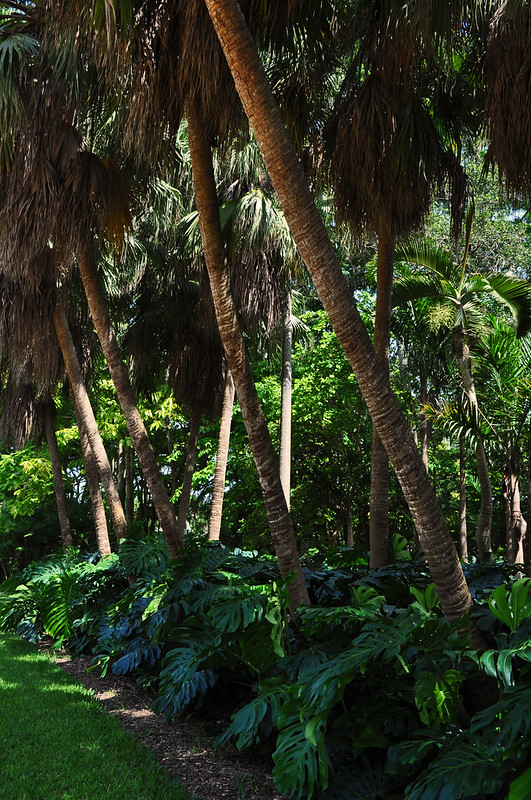
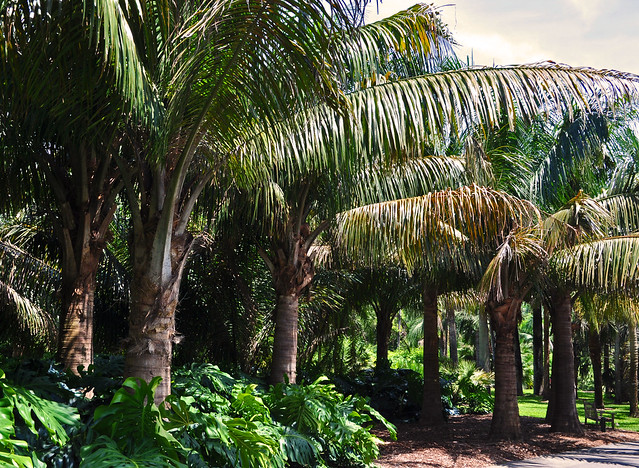





les,the Bailey palm pic was genius...real art!
ReplyDeleteFrom one tree person to another, thank you for a great posting on some really unusual trees. Love that Rainbow Eucalyptus.
ReplyDeleteSo sad that there are only 15 Haitian Oil Palms left in the world. Do these fruit? Is it possible to propagate through seeds?
I have never seen a Bismarckii nobilis of that size, amazing! So many beautiful trees, and bark...of course!
ReplyDeletelovely pictures !!!! I am lookinf forward to see the rest !
ReplyDeleteMy money's on the Rainbow eucalyptus. Don't have your affinity for palms, other than as geometric shapes.
ReplyDeleteSo many gorgeous trees, especially the bark close ups, so little time.
ReplyDeleteLove the Cubian Bailey Palms. I am really enjoying your Florida travelogue.
ReplyDeleteAdore the trees, especially a gorgeous tree that can make men weep. Could the curvaceous roots belong to the Moreton Bay fig. I saw similar roots on these figs in Balboa Park this spring....
ReplyDeleteJust Beautiful, Les. I think as a Southerner in a zone 8 region, attraction to palms is normal, if not even overlooked often. The key is designing well with the palms and good species, such as the many Sabals that do well here. We have realized that a number of species are quite sustainable and have a home in our New American gardens in the South.
ReplyDeleteLes,
ReplyDeletethe Pettycoat Palm picture is just wonderful. You have such an eye, I keep trying to improve mine. Looks like you had a great trip.
What amazing trees Les!
ReplyDeleteSharon,
ReplyDeleteThe art was Mother Nature's, I just snapped the photo.
Janet,
The Haitian oil palms do fruit and they were a source of food and oil, plus the wood is insect resistant. It sound entirely useful.
Loree,
Those large Bismarcks were totally distracting.
Gwennie,
Thanks for stopping by, there should be another post up soon.
James,
At one time palms did nothing for me, except when I saw them used in inappropriate landscapes where they bothered me. Now I am much more open to them, but I will never be one of those people who go to extroidinary measures to keep something alive way out of its zone.
Carolyn,
Yes indeed, so little time.
Vikki,
Thanks for tagging along. I have enough material for maybe 3 more posts.
Annie,
Those roots reminded me of one of those pin-up pictures from another era where the leggy beauty was all draped over a settee.
John,
I agree totally. I think in Va. gardens I prefer to see the dwarf Sabals as a texture in the garden, and for the fact they only hint at the tropics without hitting you over the head with it.
Randy,
The pettycoats were fat palms, shorter than the others. All their green foliage was at the top, and they had full length skirts of brown all the way to the ground.
Jennifer,
Yes they were.
Les
Yeah I'm a tree geek too. I remember when I saw my first eucalyptus tree, off all places Laredo Texas. Not quite the same as that one however. Beautiful tour. I'm in love with the Bismarckii.
ReplyDeleteThis comment has been removed by a blog administrator.
ReplyDeleteThe tree with the amazing buttress roots is a Pachira aquatica, a member of the Bombacoideae tribe of the Malvaceae (former Bombacaceae).
ReplyDeleteGreggo,
ReplyDeleteAbout 6 years ago we had a cart full of herbs overturn at work, it included some tiny little Eucalyptus in 2" pots. I planted one that is not close to 12' tall.
Barry,
Thank you so very much for the ID. I looked and looked to no avail.
Les
Oh...I love your garden trellises over the walking path. Beautiful idea.The borage looks so healthy and full. You must have sent us some of your rain because we got some much needed rain today. Your back garden looks like a respite and a spot to enjoy all of the work you put into the garden. It is very beautiful.Hyderabad Flowers
ReplyDelete